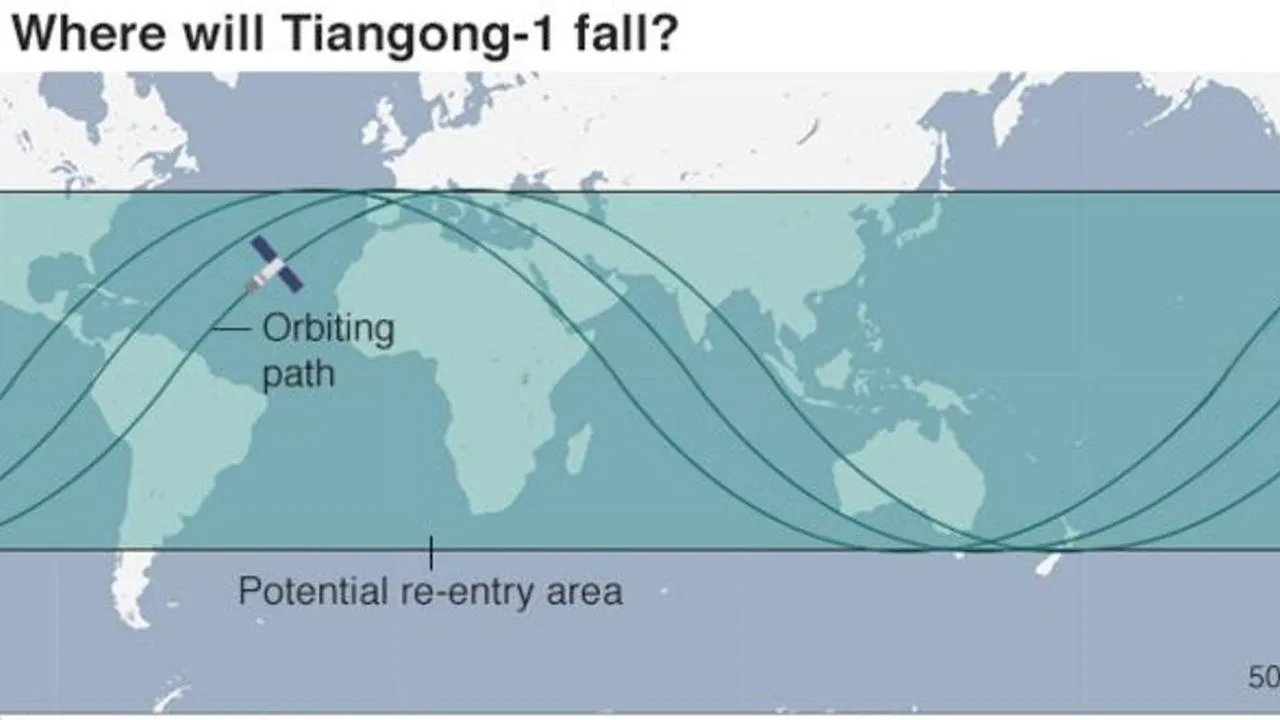
LONDON (AFP) - China's space station, Tiangong-1, is certain to fall to Earth later this week.
With a length of more than 10 meters and weighing more than 8 tons, Tiangong-1 is larger than most of the man-made objects that routinely reenter the Earth's atmosphere.
China has lost all communication with the station, and thus the fall of the 'Celestial Palace' - as Tiangong means - will not be controlled.
However, experts say there is a risk - albeit very low - that any unburned Tiangong section will hit the densely populated area.
"Given that Tiangong-1 has a larger and stronger mass, than many other space objects falling uncontrollably to Earth from space, the fraction of the satellite is a concern," explains Richard Crowther, Chief Engineer of the British Space Agency as quoted by the BBC Friday (30/3/2018).
"The majority of these satellites can be expected to burn as long as it enters the Earth's atmosphere with the greatest probability being that any surviving fragments will fall into the sea," he said.
Launched in 2011 and visited by six Chinese astronauts, Tiangong should return to Earth in a planned manner. Namely, by using the thrusters to a remote zone in the Southern Ocean, also known as the Antarctic Ocean. However, all the command links suddenly disappear by 2016, and now nothing can be done to direct where the Heavenly Palace fell.
Thirteen space agencies, under the leadership of the European Space Agency, are now following in the footsteps of Tiangong around the world, modeling his behavior as he descends deeper into the atmosphere.
The group, known as the Interagency Space Space Coordination Committee (IADC), is trying to estimate the time and place most likely to fall Tiangong-1.
There is a lot of uncertainty about it, that means a definitive statement can only be done near the end of Tiangong-1's journey.
"The assurance of Tiangong's fall is probably an hour before, and an hour means almost a revolution around Earth," said Holger Krag, head of the Esa space debris office.
So far what can be said with certainty is that nothing will fall beyond 43 degrees from the Equator, North Latitude or South Latitude. Includes the Mediterranean region to Tasmania.
The estimate was obtained from where Tiangong was first launched.
China has limited national tracking facilities around the world. So, have no choice but to keep the fall of Tiangong-1 on the Equator path quite tight.
Although some 5.2 billion people live in the re-entry zone (an area where celestial bodies can reach Earth's atmosphere), most of it is sea, which explains the high probability that any debris that survives on the surface will hit the water.
"We know from similar incidents that on average between 20% and 40% of the initial mass have a chance to survive during re-entry," says Krag.
"We can apply this rule to Tiangong," he continued.
"So that means that between 1.5 tons and 3.5 tons will fall to earth, the rest burning during re-entry," he said explaining the possibility of the fall of Tiangong-1.
The components that most often do not burn in the atmosphere are tanks. These objects are interior to the spaceship and are protected.
But they are also made of steel, titanium or carbon-reinforced plastic and materials that are generally more resistant to high temperatures if they become exposed. Thus, it is likely that the object will survive when Tiangong-1 goes back to Earth.
The Greatest Space that Falls to Earth?

Tiangong belongs to a large object that enters the Earth's atmosphere uncontrollably, but historically it is not the greatest.
Skylab belonging to the US space agency nearly 80 tonnes of mass when it returned to Earth uncontrollably in 1979.
Parts of the Skylab shards fell into Western Australia, but no one was hurt.
The space shuttle Columbia NASA is also classified as an uncontrolled object entry to Earth. Its mass is over 100 tonnes when it struck Earth tragically from orbit in 2003.
Again, no one on Earth is exposed to debris scattered throughout the states of Texas and Louisiana.
Jonathan McDowell of the Harvard-Smithsonian Center for Astrophysics, considers Tiangong only one of the 50 largest objects to fall to Earth without control.
China has already launched its second lab, Tiangong-2, which is still operating today. The station was visited by the Tianzhou-1 spacecraft to refuel by 2017.
Tiangong is prepared to demonstrate the ability of meetings and orbital circulation - an example for where to train activities in a more permanent space station China.
This facility, which is expected to consist of a large core module and two smaller additional modules, will operate in the early decades to come.
The new rocket, Long March 5, was recently introduced to do the weight lifting that would be required to lay core modules in orbit.
Vote good-karma As Witness || Vote bue As Witness || Vote hr1 As Witness
|| Vote esteemapp As Witness ||
@minnowsupport | @bue | @hr1 | @aggroed | @busy | @extie-dasilva | @esteemapp

Download eSteem in Google Playstore => eSteem Google Playstore

Join the PALnet Discord room now => https://discord.gg/HYj4yvw "Join hundreds, or even thousands of MSP members online, anytime! The Peace, Abundance, and Liberty Discord server is the true home of the Minnow Support Project. "
I would appreciate it
Thanks :)
Vote me As Witness
